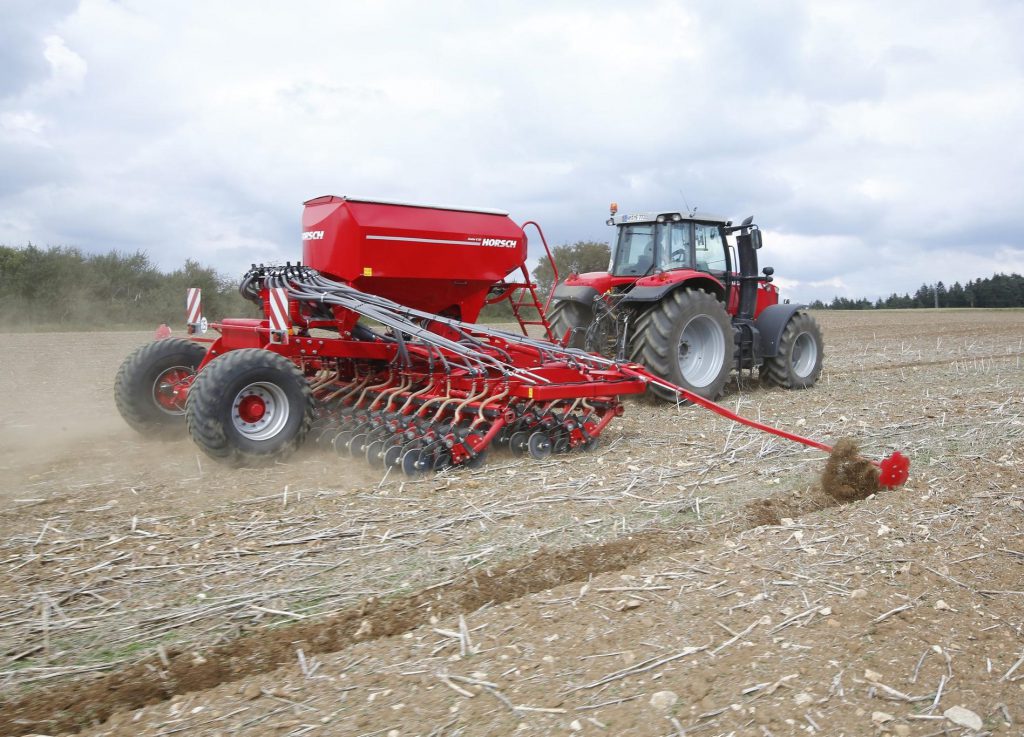German-based Horsch is best known here in Ireland for its cultivation and drilling equipment – via main agent Kellys of Borris (Co. Carlow).
Not surprisingly, drills are the best-selling product line for the German manufacturer – accounting for 33% of its €300 million turnover.
However, many moons ago, the firm also manufactured specialist ‘systems tractors’.
Its 3-wheeled Terra Trac was quite a unique offering – back in the 1980s. It boasted 250hp; the original unit was built for use on Michael Horsch’s own family farm in Germany.
He reasoned that he couldn’t find a commercially-built tractor, that could tackle the type of work that needed doing. He was chiefly concerned about the ill-effects of compaction and was looking for a tractor that could minimise ground damage.
In the years to follow, quite a number were sold across a variety of European countries – for all sorts of applications. Some, with specially-adapted frames and additional wheels, were mated to big spreaders and tankers. Others were used much like a conventional tractor would be.

Key features included the use of hydraulic motors, driving the three beefy wheels. They were said to be designed to deliver plenty of torque, addressing a criticism that is typically levelled at hydraulic drive systems.
The original prototype unit maxed out at just 12mph on the road, so it was very much a field-based machine. Under the hood was a 6-cylinder Volvo engine.
Inside the cab, the views out were reportedly good – thanks to the driver’s lofty seating position. A 170º steering angle (for the front wheel) allowed the machine to spin about almost within its own length. A ‘reverse-drive’ facility also marked the tractor out as something that was largely unique at the time. The cab could also tilt up, to provide access for maintenance.
‘Production-spec’ versions were typically fitted with both front and rear PTOs and 3-point linkages.
Horsch sows a positive seed for the future
Meanwhile, here in 2017, Horsch is storming ahead. Tractors no longer figure in the line-up; seed drills are now the top-selling machines for Horsch.
Cultivation equipment accounts for 31% of turnover, while sprayers come in at 13%. Other machines and spare parts account for the remainder of the firm’s business activity.

Despite difficulties across the whole global agricultural sector, the firm managed to increase its turnover to €300 million last year – up from €246 million the previous year.
The current year, 2017, is still being viewed with “caution”. According to Horsch, some countries are struggling with poor climatic conditions or unfavourable producer prices. Others, it says, face uncertain and disadvantageous economic or political conditions.
Horsch says that it is continuing to “invest heavily in dealer and employee development and market-specific machines”. Investments at production sites in Germany and elsewhere have “increased the company’s competitiveness and is the basis for future growth”.

Horsch’s facilities at Schwandorf, Germany
In addition to Germany, the UK, Ukraine, France and Bulgaria/Romania are key markets for the company, with “very strong seed drill sales” providing record turnover in Ukraine.
Russia, Scandinavia, Poland, the US and Canada, the Baltic States, Hungary and the Czech Republic continue to provide “stable growth”. Horsch has already founded subsidiaries in China and Brazil, where it believes there is good potential for expansion.
It says that a number of new product updates and launches are planned for later this year; expect to see these unveiled at Agritechnica 2017 in November.
Also Read: 2,900 exhibitors expected at Agritechnica later this yearHere in Ireland, one of the most high-profile recent Horsch drill deals involved the sale of one of its latest 6m-wide combined grain and fertiliser units – to Monaghan-based contractor Chambers Agri Contracts.
Pulled behind a Fendt 939, this version of the Horsch Focus TD drill carries a list price of about €90,000 excluding VAT.
